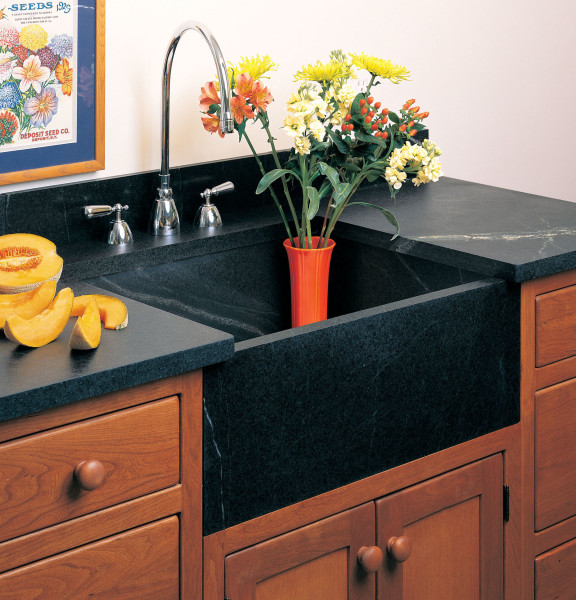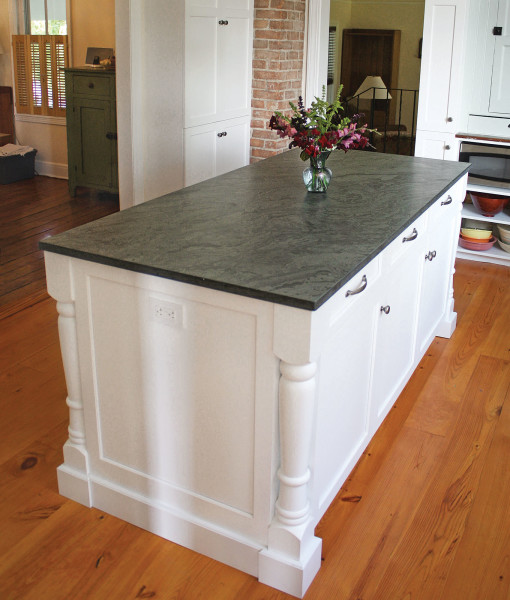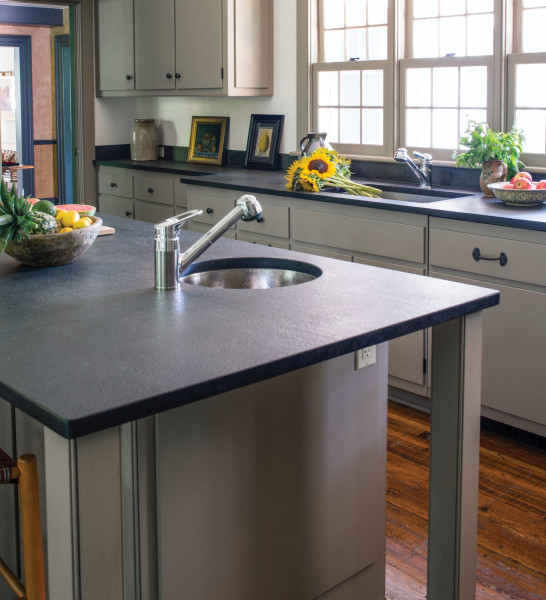Soapstone countertop and sink. Courtesy Vermont Soapstone
Would you be surprised to learn that granite is porous and thus needs more upkeep than the others? Or that soapstone used for countertops isn’t soft, like the little soapstone blocks used for carving in art class?
A metamorphic rock, soapstone is made up primarily of magnesite, dolomite, chlorite, and talc. Steatite is its geological term. Artists’ soapstone, with up to an 80% talcum content, is not the same soapstone used for countertops, with perhaps 30% talc. Because of the talcum, soapstone does have a warmer, softer or silkier feeling than granite, which is quite hard and cold.
Soapstone is completely heatproof—your whole countertop becomes a trivet. As it is nonporous, it is naturally anti-microbial, it’s nearly impervious to staining, and acid doesn’t affect it. It is a dense stone that won’t chip easily or break, but it can be scratched or dented—which can be repaired by sanding. Countertop-thickness soapstone doesn’t require a substrate for support.
Soapstone
Soapstone is not surface-perfect like Corian or laminate. It has veins and even larger streaks of quartz or crystals called amphiboles. It will change color slightly depending on degree of use, and it will pick up slight dents, thus it develops a patina. Oiled soapstone has a slight sheen, but doesn’t take a glossy surface as does polished granite. These attributes make it ideal for kitchens meant to look historical—on the other hand, soapstone can be a beautiful counterpoint in an otherwise sleek, modern kitchen.
Soapstone does not need to be sealed. Most people apply mineral oil, at least initially, to oxidize the surface, imparting an even, charcoal-to-black color. “After we install the stone, which comes out of the ground light grey, we tell people to oil it ‘once a day for a week, once a week for a month, once a month for a year’,” says Glenn Bowman of Vermont Soapstone. “If you don’t keep up, nothing bad happens.” The process is exceedingly easy: cheap drugstore-brand mineral oil is wiped on, left for five minutes, and then wiped off in several passes until the stone has no oily feel. “We’ve begun offering wax as an alternative to oil,” Bowman says. “It holds up for months, if not a year, but it’s time-consuming to apply and you have to let it cure for a week with no standing water, no appliances put back in place.”
Soapstone doesn’t offer a wide color selection. Some areas produce dark grey soapstone with black or green undertones. You can ask for a slab with a lot of veining, large mineral deposits—or not. But you won’t have the endless color, pattern, and graining options available with granites from around the world. Soapstone is quarried in slabs about 30″ deep by 7′. So extra-long countertops will need a seam. Since the stone is almost monochromatic, well-done seams are not obvious.
Slate countertop. Courtesy Sheldon Slate
Slate
Slate, too, a fine-grained sedimentary, metamorphised stone composed largely of quartz and muscovite (a mica) with biotite, chlorite, hematite, and other minerals, is durable and nonporous. Like soapstone, slate needs less fuss and upkeep than granite and certainly than marble. Slate has a subtle shift of coloration but the effect is uniform. You can get slate in black, charcoal, lighter grey or pewter, brown-black, and dark with undertones of green, purple, or red. Slate won’t easily chip or scratch and stands up to heat. On the downside, slate is slightly brittle, so less “working” of edges is done—corners can be sharp. Creating a sink is expensive. Slate is usually honed to a matte smooth finish, especially for use in kitchens.
Kitchen with granite countertops. Stacy Bass
Granite
Granite is durable and often very beautiful, with a wide range of colors and patterns. It may be highly polished or honed for a matte surface. But granite is a porous stone. It must be resealed (usually about twice a year, depending on use), and spills should be wiped up immediately. The sealer is expensive and takes some care in application.
All of these countertop materials are expensive to buy and install. Then again, they don’t wear out. When you add up the cost of stone, preparation, and installation, prices are comparable. The biggest range in materials price comes with granite, because there are so many varieties.







